-
Posts
46 -
Joined
-
Last visited
Content Type
Profiles
Forums
Articles
Gallery
Downloads
Events
Posts posted by Derek H
-
-
Hello everyone,
I finally got my hands on a few pieces of high carbon steel. I have made two knives out of it so far, but this is the only one that survived. The first one was actually nicer than this one but it broke when I tried to harden it. I was using water even though I knew better. I had enough of that first piece left to forge another blade. So here is my result so far. The blade is 2 1/2 inches long.
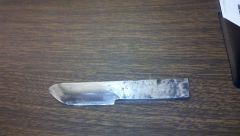
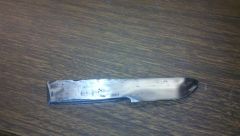
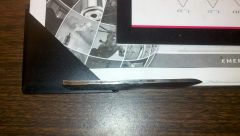
It’s not perfect, but I am very pleased with the results, especially since this is my first one. The edge is slightly off center but that’s ok. I used a crappy 6 inch bench grinder to rough it in then finished with sand paper up to 800 grit. I used peanut oil to quench in and it seems to have worked fairly well. I had it tested at work and the reading was 54 rockwell. I know it’s not ideal, but it works. And it will shave hair. Darn thing cut me twice before I even sharpened it. I havn't decided if I want to pollish this knife any farther than it is now or leave it. I am going to do a little more work on the handle but not too much as it is going to be covered up. I am fairly happy with the blade as is so I may just leave it.
I still need to make a sheath and handle for it. I have an old rifle stock that is made out of black walnut that I am thinking about using.
Let me know what you think.
And thanks in advance for any advice you can give me for the next one.
-
I am new to black smithing but have built a forge smilar to what tou are describing. My forge is 6 inch diameter and 9 inch deep. I curently have a 1" mongo burner in my forge. It gets really hot. I t also uses a lot if propain. I am currently building a 3/4 inch burner. It should ne more than enough for my forge. The suggestion given to me by some of the other members is to " build the smallest forge you can live with" and also your probably not going to want a sigle forge to do everything in. You will burn way more fuel than necessary for small things. I cant remember where it is at but i believe their are plans for a variable size forge on here somewhere. I hope this helps. Im sure some of the more experienced people on here will chime in too
-
Rich, thanks for the hint. I was under the impression that it was somethig like 4160. I need to do more research. I wonder if i could call ford and get any kind of specs.
This sight has been a ton of help getting started. Thanks everyone. -
I believe you place the steel plate into the mold and then poor in your iron. The two sould form a strong bond. I may be wrong about this however. Your best bet is to fi.d out how other anvile makers do it.
-
Rich, i agree with you. I would rather pay a little extra for a known steel with a specifice heat treat rather than having to guess at what it is and hope i got right. I have been told that leaf springs are supposed to be certain metal but can sometime vary even with a certain make and model if a car. That being said, i can get leaf spring stacks of any size (and their are some big ones) or coil springs for $18. I can get axles for $20. I snatched an axle out if a ford 9 inch the other day that i am currently attempting to make a knife and a hot cut hardy out of.
-
Thanks everyone. I am going to try to order some in a day or two. I'll post pictures of the results. Thanks again for the help
-
Wasn't sure where to put this.
I am new to knife making and so far have been using railroad spikes for practice. I have called several of the local steel suppliers but none of them have any kind of high carbon steel. Everything i have found online is ether to thin to be used for forging or is really expensive. So my question is, where does everyone get their high carbon steels from?
I really want to start making some decent knives.
Thanks for the help
-
If your planning on making small blaids i would go with the air tank. Cut it down to about 10 inches long, line with 2the inces os inswool or something similar and then about 1/4 inch of castable. You can add a small door to the back for longer blades.
This is the setup i have and it works great. I would also recamend building a 3/4 inch mongo burner. Its a little harder to build but it works great.
You can see some pictures of mine a few posts below this one. -
These are my first attempt at using my new forge. I have never done any kind of forging before this.
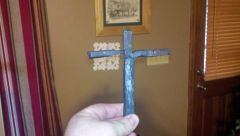
This is a split cross I made out of a railroad spike. I used an on old hatchet for a hot cut and as you can see i did not get the cuts straight or even.
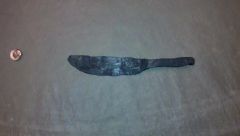
Here is my first attempt at forging a knife. It is made from a low carbon railroad spike. It is not very pretty but I don't think its bad for a first try. I made the handle to short however.
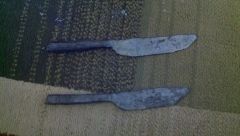
My second day of forging yielded better results i think. These two knives are also forged from railroad spikes. I still need to put a little more bevel on the edges and straighten them out some more, however i am very happy i was able to get the shape. Like i said they still need a little refining but i rain out of fuel. I know railroad spikes will not make good knives but i wanted to use them to practice getting the shape. I think they should make decent throwing knives.
Let me know what you think.
Thank you for any advice you can give me.
-
Well I finally got my forge finished after Christmas. Here are some pictures of the finished product. I am very happy with its performance right out of the box. Let me know what you think.
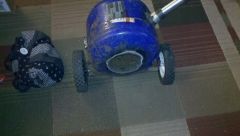
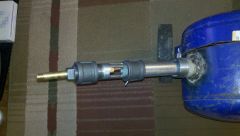
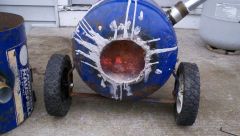
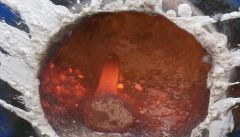
-
Thanks everyone for the input. It was just something that i thought would be cool. I may experiment with is some later on.
-
I have refinished several guns using both hot and cold gun blue. You can achieve a translucent effect with the cold blueing but its not exactly what I am wanting.
-
Hello everyone,
I was sitting at work a few days ago and had an idea for a knife. I was thinking that it would be really cool to able to make a wooden sheath for a knife and make it ether something like a sapphire blue or a blood red. Making the sheath is the easy part and not all that special in itself. What I would really like to do is to color the blade of the knife the same color. I have thought about simply painting the blade but that would not hold up well to any kind of use.
So my question is, is their a way to color a knife blade or coat it with something to color it that will hold up to light use. I want the color to be bright but translucent so that it still looks like a steel blade.
Thanks for any ideas.
-
Also take a look at the idea i posted on the ""venturi" burners". One of the guys suggested some burner experiments and I was wondering if it would helpful to / appreciated by the other people on here?
-
I am building a slightly modified version of the mongo burner. I am adding a sliding collar to adjust the airflow. I am also using slots instead of simple holes and adding a cone to help hold the flame.
I know that if you make a burner to short it will not function properly. But is their a limit on how long it can be or is it better to make a longer tube to give the gas more time to mix? Im sure this has probably been discussed somewhere else on here but I cannot find it.
-
Thank Wolverine, and congradulations to you too. I will deffinatly take fuel consumption into account. I think I am going to go ahead and finish the 1" burner since a already have the parts and build a 3/4" burner as well. That way i can change them out if I ever need the forge hotter or cooler. After all they only cost about $20 and a little time to build.
-
I had a wild thought, when I was in school senior projects were hard to come by. Maybe we can see about getting some engineering students to do the math on several burner designs, then do practical testing and find out what designs perform best AND explain why, so better "home made" burners can be built.
Downside is it might need a budget.
PhilHello everyone.
I am new to blacksmithing and I am currently going to an engineering school here in TN. I have just started building my first plumbing parts burner and I am very interested as to the effectiveness of the different styles. As senior projects have certainly not gotten any easier to find I think this would be a great one. I go back to school in January and I will run the possibility of doing this as a project by my professors. I would like to note price, ease of manufacture, BTU output, fuel consumption per BTU, and flame characteristics both inside and outside the forge for each burner. I would also like to compare the results to some of the commercially produced burners.
If my proffesors go for it, I will post the results on here. If there is anything else that should be tested let me know.
-
Thanks for the input. I was looking at it again last night and I think that I can cut the size by as much as half and it still be big enough to do almost everything that i would ever want to do. Especially if I add a small door to the back, as has been suggested on other threads, to pass longer pieces through.
-
Hello everyone,
I am new on here but have been visiting the sight for several week researching gas forges. I have finally decided to dive in and build my own. The forge I plane to build is going to 8” inner diameter and about 16” long. It is going to be made from an old air compressor tank with 2 or 3 inches of durablanket and sealed with a cast able refractory. I am planning to heat the forge with a single 1” “t-rex” style burner that I am currently in the middle of building.
My question is, will a single one inch burner be enough to get the forge to welding heat or would two ¾” burners be a better option.
I will post pictures as the build progresses, but it will most likely be after Christmas. In order to get my wife to agree to let me buy the refractory I told her it was my Christmas present and she is refusing to let me have it until then. Lol. We have only been married 6 months and life is good!!!
PS: I found my 2,300 degree 1" thick durablanket for $1 per squar foot from Porter-Warner Industries. They also have 3,000 degree castable for $23 for a 55 pound bag.

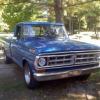
First knife
in Knife Making
Posted
Yes. I used a soldering torch to run the colors from the spin to the edge. Quenched it again when the sraw color reached the edge.